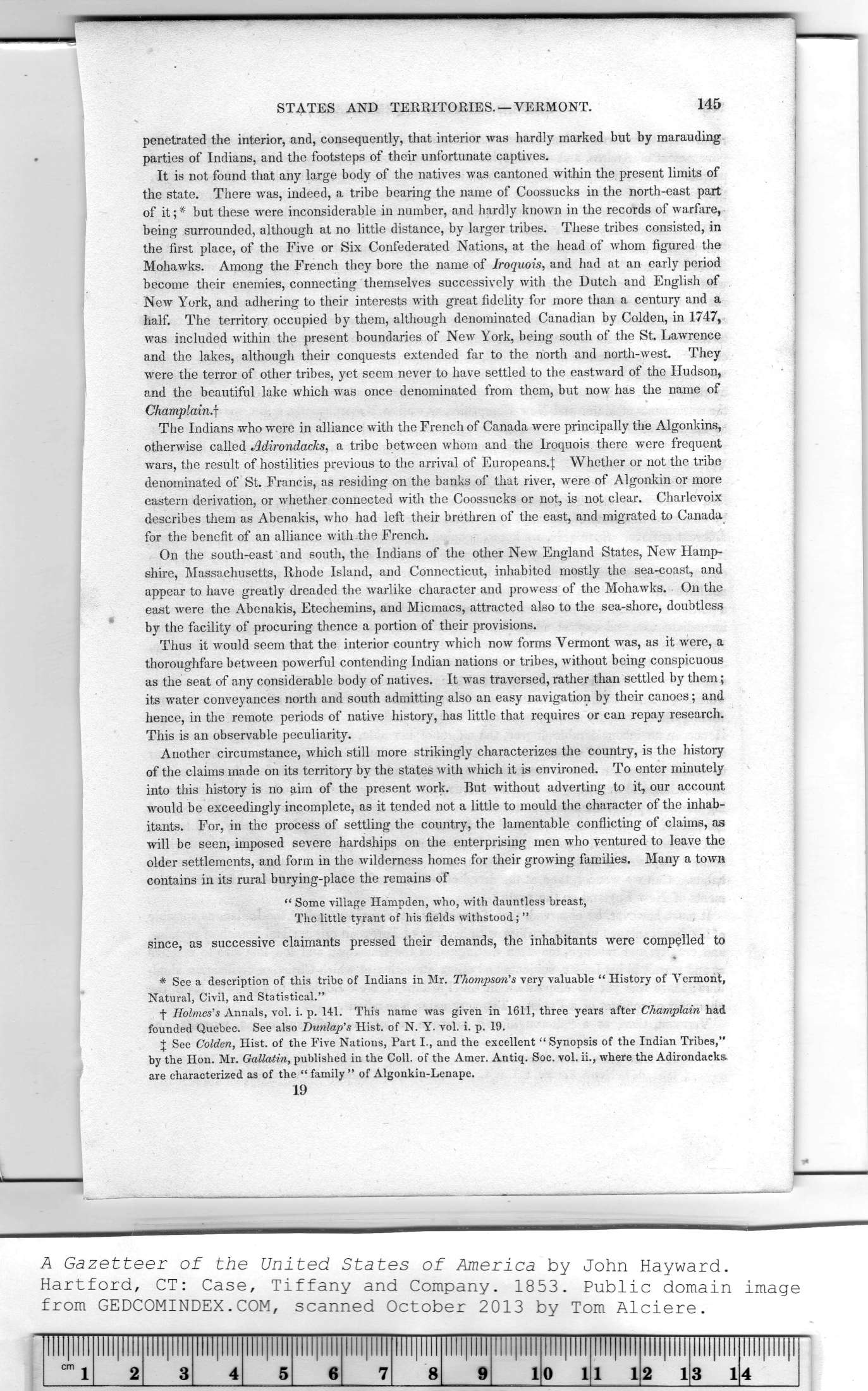|
|
Note: Ctrl and + increases the font size of the text below, Ctrl and - decreases it, and Ctrl and 0 resets it to default size.
STATES AND TERRITORIES. —VERMONT. 145
penetrated the interior, and, consequently, that interior was hardly marked but by marauding
parties of Indians, and the footsteps of their unfortunate captives.
It is not found that any large body of the natives was cantoned within the present limits of
the state. There was, indeed, a tribe bearing the name of Coossucks in the north-east part
of it; 1 but these were inconsiderable in number, and hardly known in the records of warfare,
being surrounded, although at no little distance, by larger tribes. These tribes consisted, in
the first place, of the Five or Six Confederated Nations, at the head of whom figured the
Mohawks. Among the French they bore the name of Iroquois, and had at an early period
become their enemies, connecting themselves successively with the Dutch and English of
New York, and adhering to their interests with great fidelity for more than a century and a
half. The territory occupied by them, although denominated Canadian by Colden, in 1747,
was included within the present boundaries of New York, being south of the St. Lawrence
and the lakes, although their conquests extended far to the north and north-west. They
were the terror of other tribes, yet seem never to have settled to the eastward of the Hudson,
and the beautiful lake which was once denominated from them, but now has the name of
Champlain, f
The Indians who were in alliance with the French of Canada were principally the Algonkins,
otherwise called Adirondack^, a tribe between whom and the Iroquois there were frequent
wars, the result of hostilities previous to the arrival of Europeans.:): Whether or not the tribe
denominated of St. Francis, as residing on the banks of that river, were of Algonkin or more
eastern derivation, or whether connected with the Coossucks or not, is not clear. Charlevoix
describes them as Abenakis, who had left their brethren of the east, and migrated to Canada
for the benefit of an alliance with the French.
On the south-east and south, the Indians of the other New England States, New Hamp-
shire, Massachusetts, Rhode Island, and Connecticut, inhabited mostly the sea-coast, and
appear to have greatly dreaded the warlike character and prowess of the Mohawks. On the
east were the Abenakis, Etechemins, and Micmacs, attracted also to the sea-shore, doubtless
by the facility of procuring thence a portion of their provisions.
Thus it would seem that the interior country which now forms Vermont was, as it were, a
thoroughfare between powerful contending Indian nations or tribes, without being conspicuous
as the seat of any considerable body of natives. It was traversed, rather than settled by them;
its water conveyances north and south admitting also an easy navigation by their canoes; and
hence, in the remote periods of native history, has little that requires or can repay research.
This is an observable peculiarity.
Another circumstance, which still more strikingly characterizes the country, is the history
of the claims made on its territory by the states with which it is environed. To enter minutely
into this history is no aim of the present work. But without adverting to it, our account
would be exceedingly incomplete, as it tended not a little to mould the character of the inhab-
itants. For, in the process of settling the country, the lamentable conflicting of claims, as
will be seen, imposed severe hardships on the enterprising men who ventured to leave the
older settlements, and form in the wilderness homes for their growing families. Many a town
contains in its rural burying-place the remains of
“ Some village Hampden, who, with dauntless breast,
The little tyrant of his fields withstood; "
since, as successive claimants pressed their demands, the inhabitants were compelled to
A Gazetteer of the United States of America by John Hayward.
Hartford, CT: Case, Tiffany and Company. 1853. Public domain image
1
See a description of this tribe of Indians in Mr. Thompson's very valuable “ History of Vermont,
Natural, Civil, and Statistical."
f Holmes's Annals, vol. i. p. 141. This name was given in 1611, three years after Champlain had
founded Quebec. See also Dunlap's Hist, of N. Y. vol. i. p. 19.
J See Colden, Hist, of the Five Nations, Part I., and the excellent “Synopsis of the Indian Tribes,"
by the Hon. Mr. Gallatin, published in the Coll. of the Amer. Antiq. Soc. vol. ii., where the Adirondack®,
are characterized as of the “ family " of Algonkin-Lenape.
19
|
